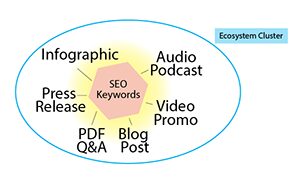Finding Value in the Value Proposition
Value Proposition. It’s a term we hear a lot in marketing and branding. But it is just marketing-speak? Or is there really value in a value proposition?
In this post, we’ll take a look a what a value proposition is, and how formulating and finalizing one for your company or brand can go a long way in making a difference in your SEO and Digital PR efforts.
I’m going to define what a value proposition is, look at its key components, and provide a simple exercise that will help you craft a value proposition for your brand or company.
For the definition, I’m going to go reference one of the modern day gurus of brand marketing, David Aaker.
Aaker is an American organizational theorist, consultant and Professor Emeritus at the University of California, Berkeley’s Haas School of Business. He is the author of more than 100 articles and 14 books on the subject of branding, including this one I highly recommend, Building Strong Brands.
Here’s Aaker’s definition of Value Proposition:
“A brand’s value proposition is a statement of the functional, emotional, and self-expressive benefits delivered by the brand that provides value to the customer. An effective value proposition should lead to a brand-customer relationship and drive purchase decisions.”
I’ll get to the statement developing exercise in a minute. First, I want to take a look at the three key benefits of the value proposition definition.
Value Proposition #1: Functional Benefit

The functional benefit is generally the most visible and common component of a value proposition. Simply put, it is the product attribute that exemplifies why a product or service is useful or desirable for a customer. The functional benefit is generally related directly to the function(s) performed by the product or service.
For example, a computer printer’s functional benefits might be speed, color, resolution, quality, etc. Generally, if a brand can dominate a key functional benefit, that brand will dominate the category. The challenge with brands who have only defined a functional benefit (no emotional or self-expressive benefit) is that they are very susceptible to competitive threats. This is because a competitor can simply copy or claim the same functional benefit, diminishing — or completely eliminating — the competitive edge a brand might hold.
Value Proposition #2: Emotional Benefit
When the purchase or use of a particular brand gives the customer a positive feeling, that brand is providing an emotional benefit. Evoking these positive feelings in a brand or marketing strategy can go a long way in separating your brand or product from competitors because emotional benefits are much more difficult to copy or claim.
Examples of brands with strong emotional benefit associations include Volvo (safety); Nordstrom (valued); Nike (athletic); Tesla (successful). A great way to learn more about your brand’s emotional benefits is to survey your customers and ask about feelings related to their association with the brand. If you start seeing recurring themes or keywords in this research, you know you are centering in on what could be a key emotional benefit.
Value Proposition #3: Self-Expressive Benefit
Brands and products can become symbols of an individual’s self-concept. This fact demonstrates how a self-expressive benefit component of the value proposition can help you separate yourself via a focused marketing strategy.
Nike’s “Just Do It” slogan is a great example of a successful execution for a self-expressive benefit. Consider this: consumers (who may not even be athletes) pay Nike to promote the brand through the logo visibility on the purchase of shoes, t-shirts and other wearables. The result for Nike is a (very profitable) brand asset the company can charge a premium for that can be leveraged across multiple market channels and segments. And, once a consumer identifies with a brand through a self-expressive benefit, it is very difficult to get that consumer to switch brands, and relatively easy to get them to promote it.
Developing Your Value Proposition
So with these three basic benefits identified, how can you go about developing a value proposition for your brand? The following template is a good starting point. Simply fill in the bracketed areas for your company or brand. One key criteria: it’s important to be as specific, but brief, as possible in the entry areas.
To [TARGET AUDIENCE], [BRAND or PRODUCT] is the [WHAT] that [DOES WHAT] so that [BENEFIT/RESULT].
Here’s an example of how this might look for TechServ, a fictional company that offers computer repair and upgrade tech services for small businesses.
To [IT professionals and small business owners], [TechServ] is the [customer service-oriented tech repair and computer upgrade firm] that [delivers peace of mind and quick, responsive service with regards to PC and Mac repairs and upgrades] so that [business owners and IT professionals can rest assured knowing they can focus on business operations and profitability without worrying about computer problems or downtime].
Notice how this company’s value proposition extends beyond the functional benefit of computer repair. TechServ is in the customer peace of mind business, not the computer repair business. This is an important point, because functionally, a computer repair service had better be able to fix computers in a timely manner. Marketing your product or company needs to be built on something beyond a functional benefit that is a baseline standard across the industry.
The value proposition exercise helps you hone in on those qualities that may not be as apparent, but that offer a unique positioning advantage in the marketplace.
The focus away from promoting a functional benefit to a strong emotional benefit — that of a business owner or IT person being able to relax knowing that tech needs will be taken care of without impacting the company’s daily operations or profits — helps define the brand personality of the company, setting it apart from the other “repair shop” companies who are no longer positioned as threats or competitors.
The Content Distribution Ecosystem

Note that the value proposition is a core component of the purpose behind an integrated messaging strategy. One good example of how this strategy can be set up is with the Content Distribution Ecosystem. The Content Distribution Ecosystem is made up of individual content “clusters” that are thematically and contextually connected for greater visibility.
The Content Distribution Ecosystem is an important part of a Digital PR Strategy. Digital PR is defined as the process of creating and sustaining an influential presence on the digital web. Learn more about Digital PR in this You Tube video.

Bill Threlkeld is the president of Threlkeld Communications, a Digital Public Relations and SEO consultancy that helps businesses create and sustain an influential presence on the digital Web. He can be reached at bill@threlkeldcomm.com
